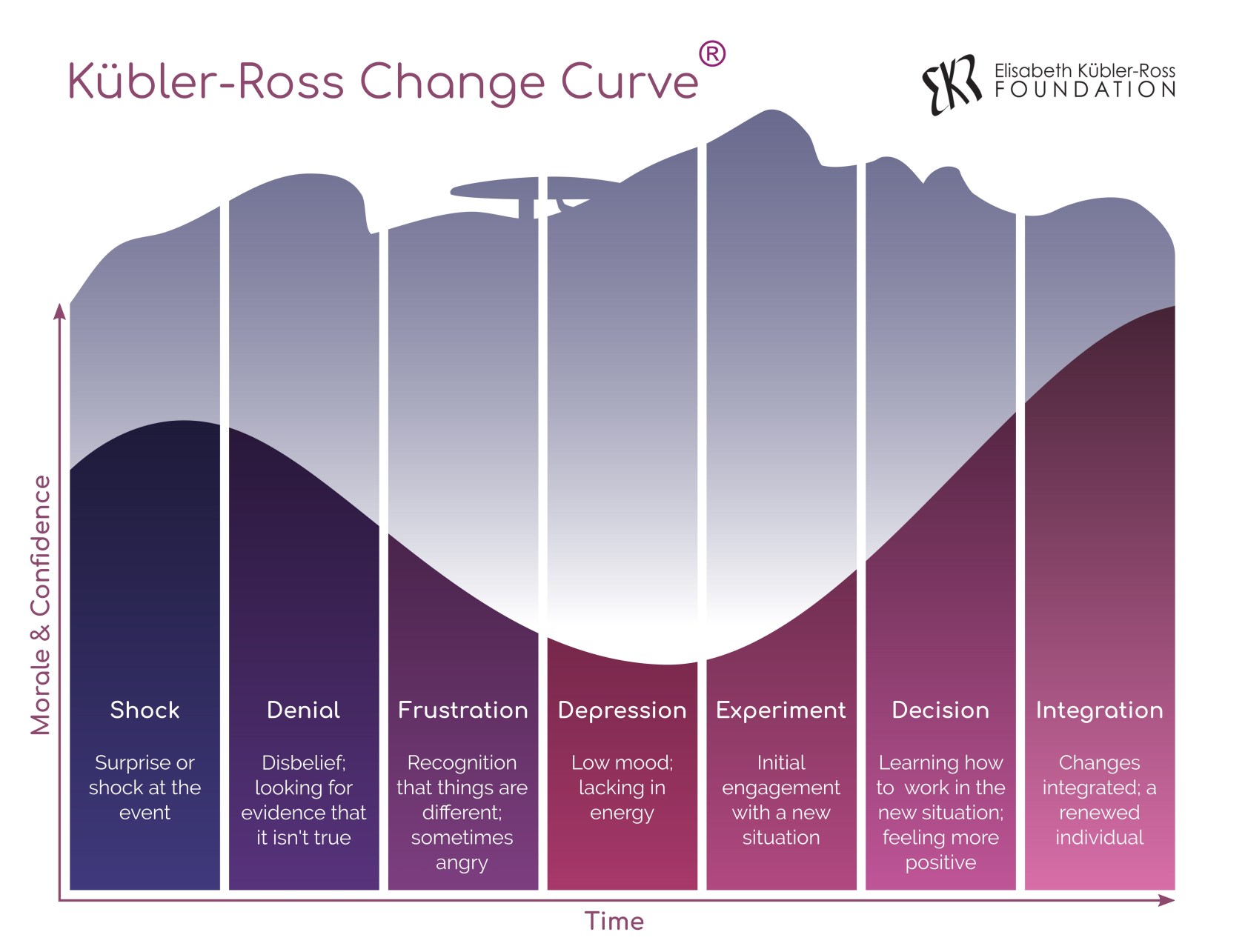February 9, 2021
The Kübler-Ross Change Curve®, adapted from the original five stages of grief (originally published in 1969), has been expanded to reflect a highly applicable curve for adapting to any change. In this case, the change curve is organizational, and the change is the introduction of an enterprise quality management system (EQMS).
When leadership first announces the decision to select new software and perform an EQMS implementation, team members may initially experience shock and denial. They may believe that the plan is just another flavor-of-the-day initiative. Once the project is confirmed, employees may be frustrated about changes to their responsibilities. They may respond with despondence and unhappiness. It’s a scientific and understandable response for people to resist change.
Then, the curve changes. Users experiment with the new software and see that it helps them be more efficient. They decide to try to work with the new digital process since they are aware this is the new normal. Slowly but surely, the doubters become advocates who help lead the change, reaching the final integration stage.
The question is: how do you encourage that change and ensure a successful implementation that doesn’t waste time and resources? Let’s look at some key elements of success.
Communicating the Vision to Minimize
Top leadership’s main contribution to the EQMS implementation process is providing the vision for how different the organization will look once the transformation is complete. This involves making the case for change in a clear, concise, conversational statement.
Points to focus on include:
- Reassure the team that you are not trying to reduce staff, which is a common fear.
- Show examples of how an EQMS will help make their jobs easier and minimize wasted time based on the past system.
- Highlight how the reduction in fire drills and paperwork leaves more time for projects that add value, improve business performance, and create a higher quality product(s).
Good communication is essential for a successful change process. Sending out weekly project updates, not just to team members but also senior leadership, creates transparency and provides an easily accessible reference source of project information. Highlight significant milestones and recognize individual and team contributions. Create an atmosphere of shared success.
Involving the Shop Floor
Shop floor employee involvement is crucial to requirements gathering, ensuring the new system is aligned with their needs. They are the ones who must live with it every day, and it is ultimately whether they choose to embrace the quality management system that will make or break the project.
Here you will want to encourage participation in meetings by:
- Make it clear that everyone leaves their title at the door.
- Ask open-ended questions to generate more in-depth responses.
- Elicit contributions from those that may be hesitant to speak up by asking them to share their personal insights, experiences, and stories.
- Verify your understanding of the future state and how it will change their day-to-day operations as a key milestone that leaders must track.
Consider how working in today’s virtual environment may be applicable. It’s important to note that the new normal of remote work requires greater preparation from project leadership in order to have productive virtual meetings.
Enlisting Early Adopters
At these early stages, you also should identify early adopters. These people are typically passionate about technology or process improvement, and often contribute ideas or point out new automated tools.
Harness the passion in these core people who are aligned with leadership’s vision. They can bring energy to the EQMS implementation to help it keep moving forward through the inevitable bumps in the road and leverage their relationships to share the project vision.
Early adoptions should come from the shop floor, middle management, and even occasionally at the senior level. They aren’t just advocates, but also guides and mediators, helping to anticipate challenges and drive the project forward. They can become process owners, training champions, and/or process subject matter experts (SMEs) that support the user community.
The reporting and analytics team should also be involved early. Most projects bring them in after requirements and configurations are complete. At that point, making changes can upend the project plan. This team provides suggestions on how to integrate data from other systems as well as improve analytics and KPIs.
Building Critical Mass
At this phase, early successes start to draw people into the process. While people may have resisted change to this point, now they begin to see how the EQMS software makes life easier and delivers business improvements.
During this time, leadership must review milestones and keep their finger on the pulse of the project. If they sense a loss of energy or momentum, they can empower the project leaders to restate objectives, conduct awareness training, or update the communication plan.
Develop an internal marketing plan to complement the communication plan. Identify ways to promote the project, injecting some fun and keeping the team energized by celebrating milestones with games, prize drawings, or even a project-naming contest with gifts or other acknowledgment. Enabling the user community to participate in the project or QMS name provides powerful internal recognition. That name can then be added to existing procedures and training for immediate branding.
Start with Small EQMS Implementation Wins
One pitfall to avoid is trying to execute too much change too fast. For example, trying to digitize all QMS processes at once can overwhelm your user community and set you back in the long run.
Instead, start with a smaller set of processes, some that may have interdependencies, looking to leverage quick wins for the continued moment. By the time you’re ready to release the next application, less training is needed and the overall project starts accelerating, with fewer changes users must learn.
Helping Slow Adopters Catch Up
Emotional intelligence is a vital aspect of any organizational change. As an agent of change, it is so important to identify anyone still lagging and reach out to them for one-to-one conversations (rather than a meeting).
At this point, leaders must work to:
- Uncover individuals’ underlying objections or fears.
- Frame the change as a positive.
- Help people see how they can contribute, perhaps by identifying a hidden talent or strength.
You may need to reiterate that this isn’t a resource-trimming project, but instead, something that will allow them to pursue that process improvement they’ve talked about for years.
Fortunately, when you can bring them to your side, often this small group will talk amongst themselves. In sharing what made them rethink their position, additional people are persuaded to get on board with the changes.
At the end of the day, being an agent of change requires much more than just dictating changes from the top down. Instead, it’s about finding ways to engage and empathize with your team, so they see the value in change and join the effort willingly.
Without this approach, you risk falling back into past inefficiencies and quality issues. Implemented in this way, however, your EQMS implementation and utilization becomes part of daily operations and the cornerstone of what you do.



